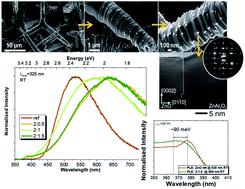当前位置:
X-MOL 学术
›
Nanoscale Adv.
›
论文详情
Our official English website, www.x-mol.net, welcomes your feedback! (Note: you will need to create a separate account there.)
ZnAl2O4 decorated Al-doped ZnO tetrapodal 3D networks: microstructure, Raman and detailed temperature dependent photoluminescence analysis
Nanoscale Advances ( IF 4.7 ) Pub Date : 2020-03-19 , DOI: 10.1039/c9na00730j Joana Rodrigues 1 , Matthias Hoppe 2 , Nabiha Ben Sedrine 1 , Niklas Wolff 3 , Viola Duppel 4 , Lorenz Kienle 3 , Rainer Adelung 2 , Yogendra K Mishra 5 , Maria R Correia 1 , Teresa Monteiro 1
Nanoscale Advances ( IF 4.7 ) Pub Date : 2020-03-19 , DOI: 10.1039/c9na00730j Joana Rodrigues 1 , Matthias Hoppe 2 , Nabiha Ben Sedrine 1 , Niklas Wolff 3 , Viola Duppel 4 , Lorenz Kienle 3 , Rainer Adelung 2 , Yogendra K Mishra 5 , Maria R Correia 1 , Teresa Monteiro 1
Affiliation

|
3D networks of Al-doped ZnO tetrapods decorated with ZnAl2O4 particles synthesised by the flame transport method were investigated in detail using optical techniques combined with morphological/structural characterisation. Low temperature photoluminescence (PL) measurements revealed spectra dominated by near band edge (NBE) recombination in the UV region, together with broad visible bands whose peak positions shift depending on the ZnO : Al mixing ratios. A close inspection of the NBE region evidences the effective doping of the ZnO structures with Al, as corroborated by the broadening and shift of its peak position towards the expected energy associated with the exciton bound to Al. Both temperature and excitation density-dependent PL results pointed to an overlap of multiple optical centres contributing to the broad visible band, with the peak position dependent on the Al content. While in the reference sample the wavelength of the green band remained unchanged with temperature, in the case of the composites, the deep level emission showed a blue shift with increasing temperature, likely due to distinct thermal quenching of the overlapping emitting centres. This assumption was further validated by the time-resolved PL data, which clearly exposed the presence of more than one optical centre in this spectral region. PL excitation analysis demonstrated that the luminescence features of the Al-doped ZnO/ZnAl2O4 composites revealed noticeable changes not only in deep level recombination, but also in the material's bandgap when compared with the ZnO reference sample. At room temperature, the ZnO reference sample exhibited free exciton resonance at ∼3.29 eV, whereas the peak position for the Al-doped ZnO/ZnAl2O4 samples occurred at ∼3.38 eV due to the Burstein–Moss shift, commonly observed in heavily doped semiconductors. Considering the energy shift observed and assuming a parabolic conduction band, a carrier concentration of ∼1.82 ×1019 cm−3 was estimated for the Al-doped ZnO/ZnAl2O4 samples.
中文翻译:

ZnAl2O4 装饰的 Al 掺杂 ZnO 四足 3D 网络:微观结构、拉曼和详细的温度相关光致发光分析
用 ZnAl 2 O 4装饰的 Al 掺杂 ZnO 四足体的 3D 网络使用光学技术结合形态/结构表征详细研究了通过火焰传输方法合成的颗粒。低温光致发光 (PL) 测量揭示了紫外区域中以近带边缘 (NBE) 复合为主的光谱,以及其峰值位置随 ZnO: Al 混合比而变化的宽可见带。对 NBE 区域的仔细检查证明了 ZnO 结构与 Al 的有效掺杂,正如其峰值位置向与结合到 Al 的激子相关的预期能量的加宽和偏移所证实的那样。温度和激发密度相关的 PL 结果都表明多个光学中心的重叠有助于宽可见带,峰位置取决于 Al 含量。虽然在参考样品中,绿色波段的波长随温度保持不变,但在复合材料的情况下,深能级发射随着温度的升高显示出蓝移,这可能是由于重叠发射中心的明显热猝灭。时间分辨的 PL 数据进一步验证了这一假设,该数据清楚地揭示了在该光谱区域中存在多个光学中心。PL激发分析表明Al掺杂的ZnO/ZnAl的发光特征 这清楚地暴露了在该光谱区域中存在多个光学中心。PL激发分析表明Al掺杂的ZnO/ZnAl的发光特征 这清楚地暴露了在该光谱区域中存在多个光学中心。PL激发分析表明Al掺杂的ZnO/ZnAl的发光特征与 ZnO 参考样品相比, 2 O 4复合材料不仅在深能级复合方面发生了显着变化,而且在材料的带隙方面也发生了显着变化。在室温下,ZnO 参考样品在 ∼3.29 eV 处表现出自由激子共振,而 Al 掺杂 ZnO/ZnAl 2 O 4样品的峰位置由于 Burstein-Moss 位移而出现在 ∼3.38 eV 处,通常在大量观察到掺杂半导体。考虑到观察到的能量偏移并假设一个抛物线导带,估计Al掺杂的ZnO/ZnAl 2 O 4样品的载流子浓度为~1.82×10 19 cm -3 。
更新日期:2020-03-19
中文翻译:

ZnAl2O4 装饰的 Al 掺杂 ZnO 四足 3D 网络:微观结构、拉曼和详细的温度相关光致发光分析
用 ZnAl 2 O 4装饰的 Al 掺杂 ZnO 四足体的 3D 网络使用光学技术结合形态/结构表征详细研究了通过火焰传输方法合成的颗粒。低温光致发光 (PL) 测量揭示了紫外区域中以近带边缘 (NBE) 复合为主的光谱,以及其峰值位置随 ZnO: Al 混合比而变化的宽可见带。对 NBE 区域的仔细检查证明了 ZnO 结构与 Al 的有效掺杂,正如其峰值位置向与结合到 Al 的激子相关的预期能量的加宽和偏移所证实的那样。温度和激发密度相关的 PL 结果都表明多个光学中心的重叠有助于宽可见带,峰位置取决于 Al 含量。虽然在参考样品中,绿色波段的波长随温度保持不变,但在复合材料的情况下,深能级发射随着温度的升高显示出蓝移,这可能是由于重叠发射中心的明显热猝灭。时间分辨的 PL 数据进一步验证了这一假设,该数据清楚地揭示了在该光谱区域中存在多个光学中心。PL激发分析表明Al掺杂的ZnO/ZnAl的发光特征 这清楚地暴露了在该光谱区域中存在多个光学中心。PL激发分析表明Al掺杂的ZnO/ZnAl的发光特征 这清楚地暴露了在该光谱区域中存在多个光学中心。PL激发分析表明Al掺杂的ZnO/ZnAl的发光特征与 ZnO 参考样品相比, 2 O 4复合材料不仅在深能级复合方面发生了显着变化,而且在材料的带隙方面也发生了显着变化。在室温下,ZnO 参考样品在 ∼3.29 eV 处表现出自由激子共振,而 Al 掺杂 ZnO/ZnAl 2 O 4样品的峰位置由于 Burstein-Moss 位移而出现在 ∼3.38 eV 处,通常在大量观察到掺杂半导体。考虑到观察到的能量偏移并假设一个抛物线导带,估计Al掺杂的ZnO/ZnAl 2 O 4样品的载流子浓度为~1.82×10 19 cm -3 。


























 京公网安备 11010802027423号
京公网安备 11010802027423号